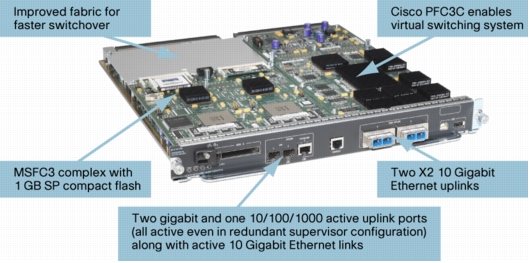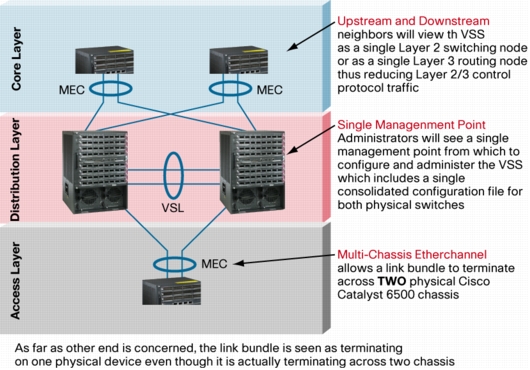|
|
Product Overview
• Two X2-based 10 Gigabit Ethernet ports, ideal for high-density access and aggregation areas such as data center, LAN campus, and backbone areas.
• Two Gigabit Ethernet Small Form-Factor Pluggable (SFP) ports and one 10/100/1000 gigabit port for additional flexibility. All the links in the Cisco Virtual Switching Supervisor Engine 720 can be active simultaneously even in the redundant configurations, thereby increasing the supervisor throughput from 48 to 82 Mpps. This improves total system performance to 450 Mpps for IPv4 traffic and 225 Mpps for IPv6 traffic.
• Additional fabric capabilities offering subsecond failover rates, allowing faster switchover to a standby supervisor. The Cisco Virtual Switching Supervisor Engine 720 with 10 Gigabit Ethernet uplinks is supported on Cisco IOS® Software.
Figure 1. Cisco Virtual Switching Supervisor Engine 720 Features

Figure 2. System Virtualization Using the Cisco VSS 1440

• Increases operational efficiency: Using Multichassis EtherChannel, the Cisco VSS 1440 eliminates the need for Hot Standby Router Protocol/Virtual Router Redundancy Protocol/ Gateway Load Balancing Protocol (HSRP/VRRP/GLBP) configuration and allows customers to use a standards-based aggregation mechanism for server network interface card (NIC) teaming across redundant switches. Since multiple Cisco Catalyst 6500 Series Switches are viewed as one virtual switch, the management overhead is reduced by at least 50 percent. Using the Cisco VSS 1440, only one gateway IP address is required per VLAN, instead of the current requirement of three IP addresses per VLAN.
The Cisco VSS 1440 is flexible enough to be deployed in separate geographical locations. CiscoWorks further eases Cisco VSS 1440 management by seeing two Cisco Catalyst switches as one virtual switch.
• Boosting nonstop communication: The Cisco VSS 1440 uses Multichassis EtherChannel for link failover and eliminates Layer 2 and 3 protocol reconvergence. This results in a deterministic, subsecond virtual switch recovery avoiding any disruption to applications that rely on network state information (such as forwarding table information, NetFlow, Network Address Translation [NAT], authentication, or authorization).
• Scales system bandwidth capacity to 1.4 Tbps: The Cisco VSS 1440 provides automatic, even load sharing by using all the available Layer 2 bandwidth across redundant Cisco Catalyst 6500 Series Switches. The Cisco VSS 1440 eliminates unicast flooding caused by asymmetrical routing in the campus, and maximizes the use of all of the 10-gigabit ports in a virtual switch.
• Uses existing multilayer switching architecture: Unlike many new technologies, the Cisco VSS 1440 eases deployment by using customers' existing Cisco Catalyst 6500 Series investments and by supporting standards-based 10 Gigabit Ethernet connections. Standards-based 10 Gigabit Ethernet connections between Cisco Catalyst 6500 Series Switches results in flexible distances between connections. Furthermore, the CiscoWorks LAN Management Solution (LMS) management tool converts existing switch configurations into simpler VSS 1440 configurations, simplifying deployment.
• Provides slot efficiency: With two X2-based 10 Gigabit Ethernet uplinks built into the supervisor engine, the system saves slot for additional integrated services or high-density chassis.
• Increases throughput: The Cisco Virtual Switching Supervisor Engine 720 with 10 Gigabit Ethernet uplinks enables all Gigabit Ethernet and 10 Gigabit Ethernet links to be active simultaneously. This is true for redundant systems (systems with dual supervisor engines in the chassis), thereby increasing the supervisor throughput to 82 Mpps. As a result, the system throughput increases to 450 Mpps for IPv4 traffic and 225 Mpps for IPv6 traffic.
• Improves resiliency: The Cisco Virtual Switching Supervisor Engine 720 with 10 Gigabit Ethernet uplinks includes switch fabric capabilities that offer deterministic, subsecond failover. This results in faster switchover to a standby supervisor.
Table 1. Specifications of the Cisco Virtual Switching Supervisor Engine 720 with 10 Gigabit Ethernet uplinks
Application Areas
Summary/Conclusion
Table 2. Product Specifications for the Cisco Virtual Switching Supervisor Engine 720 with 10 Gigabit Ethernet uplinks
|
Product |
Specifications |
|
Chassis Compatibility |
• Cisco Catalyst 6503-E, 6504-E, 6506, 6506-E, 6509, 6509-E, 6509-NEB-A, 6509-V-E, 6513
• Cisco 7604, 7609, 7613
|
|
Fan Tray and Minimum Power Supply Required |
• E Chassis supports Cisco Virtual Switching Supervisor Engine 720
• 2500W AC or DC
• Non E Chassis requires the following:
• High-speed fan
• 2500W AC or DC
|
|
Slot Requirements |
Occupies the following slots in the chassis: • 3-slot chassis: slots 1 and 2
• 4-slot chassis: slots 1 and 2
• 6-slot chassis: slots 5 and 6
• 9-slot chassis: slots 5 and 6
• 13-slot chassis: slots 7 and 8
|
|
Software Compatibility |
• Cisco Catalyst 6500 Series
• Cisco IOS Software Release 12.2(33)SXH and later
• Cisco 7600 Series
• Cisco IOS Software Release 12.2(33)SXH and later
|
|
Protocols |
• Layer 3 routing protocols, Border Gateway Protocol version 4 (BGPv4), Open Shortest Path First (OSPF), Intermediate System-to-Intermediate System (IS-IS), Enhanced Interior Gateway Routing Protocol(EIGRP), Routing Information Protocol (RIP), Distributed FIB Switching, Cisco Discovery Protocol, Internet Control Message Protocol (ICMP)
• Multicast forwarding, Protocol independent Multicast (PIM) (both sparse and dense mode), (S,G), (*,G), Bidirectional PIM in hardware
• Comprehensive MPLS support
• Cisco Group Management Protocol and Internet Group Management Protocol (IGMP) snooping
|
|
Memory |
• Cisco Virtual Switching Supervisor Engine 720 3C supports 1 GB of DRAM for the route processor and 1 GB for the switch processor
• Cisco Virtual Switching Supervisor Engine 720 3CXL supports 1 GB DRAM for the route processor and 1 GB DRAM for the switch processor
• 1 GB compact flash for switch processor and 64 MB of boot flash for route processor
|
|
Storage Options |
Removable storage: 256 MB, 512 MB, 1 GB (compact flash) |
|
Uplink Ports |
Two 10 Gigabit optics (X2) ports, two Gigabit Ethernet SFP ports, one selectable 10/100/100 RJ-45 |
|
Console Ports |
One (RS-232) |
|
USB Ports |
• One host and one device port**
|
|
Reliability and Availability |
• Virtual Switching System (VSS)
• Fast software upgrade
• Route Processor Redundancy+ (RPR+)
• Stateful Switchover + Nonstop Forwarding (SSO + NSF)
• Online insertion and removal (OIR) hot swap
• Fast fabric switchover
|
|
MIBs |
• MPLS LDP MIB, MPLS Label Switch Router (LSR) MIB, MPLS-TE MIB, MPLS VPN MIB; see software release notes for additional information
• Check the following MIB finder for more information: http://www.cisco.com/public/sw-center/netmgmt/cmtk/mibs.shtml
|
|
Network Management |
CiscoWorks |
|
Physical Specifications |
• (H x W x D): 1.6 x 15.3 x 16.3 in. (4.0 x 37.9 x 40.3 cm)
• Weight: 11.5 lb; 12.5lb with Optics and SFP
|
|
Power Consumption |
• Cisco Virtual Switching Supervisor Engine 720 3C (includes PFC3C): 338W
• Cisco Virtual Switching Supervisor Engine 720 3CXL (includes PFC3CXL): 363W
|
|
Environmental Conditions |
• Operating temperature: 32 to 104°F (0 to 40°C)
• Storage temperature: -40 to 158°F (-40 to 70°C)
• Relative humidity, operating, noncondensing: 10 to 90%
• Relative humidity, nonoperating, noncondensing: 10 to 95%
• MTBF: Demonstrated 85,000 hours
|
|
EMI and EMC Compliance |
• FCC Part 15 (CFR 47) Class A
• ICES-003 Class A
• EN 55022 Class A
• CISPR 22 Class A
• AS/NZS 3548 Class A
• VCCI Class A
• EN 55024
• EN300 386
• EN 50082-1
• EN 61000-3-2
• EN 61000-3-3
• EN 61000-6-1
• CISPR24
|
|
Safety Compliance |
• UL 60950
• CAN/CSA-C22.2 NO. 60950
• EN 60950
• IEC 60950
|
Ordering Information
Table 3. Ordering Information
Service and Support
For More Information